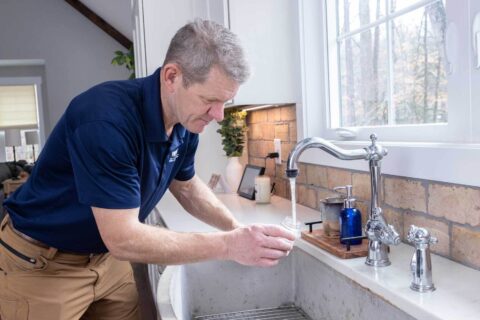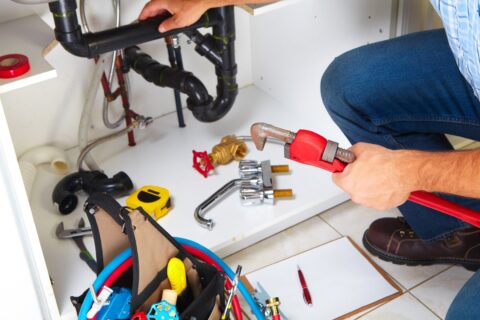8 Natural Drain Cleaning Methods You Can Try at Home
Did you know that clogged drains can lead to costly plumbing bills? Many homeowners face this issue regularly. Instead of reaching for harsh chemicals, consider drain cleaning natural remedies. These eco-friendly solutions, including natural drain cleaner and various drain cleaning methods, are effective and safe for your pipes, making them substantial DIY drain cleaning methods and clogged drain home remedies.
Using common household items like baking soda and vinegar can clear blockages without damaging your plumbing. They work wonders by breaking down grease and debris. Plus, these remedies are budget-friendly and easy to use. You can tackle minor clogs in no time. Say goodbye to expensive services and hello to simple solutions like a homemade cleaner with lemons that keep your drains flowing smoothly and act as a natural disinfectant. Discover how to maintain your home with these natural methods.
Key Takeaways
-
Natural drain cleaners like baking soda and vinegar are effective and safe alternatives to harsh chemicals.
-
Use the baking soda and vinegar method regularly to keep your drains clear and odor-free.
-
A mixture of salt and baking soda can help break down grease buildup in your pipes.
-
Combining cream of tartar with vinegar is another great way to tackle tough clogs naturally.
-
For ongoing maintenance, consider using dish soap and hot water to help prevent future clogs.
-
Keep a wire hanger handy for emergencies; it can be a simple tool to remove stubborn blockages.
Benefits of Natural Drain Cleaners
Environmental Impact
Natural drain cleaners offer significant environmental advantages. They use safe ingredients that do not harm the ecosystem. Chemical drain cleaners often contain harsh substances. These can lead to pollution when they enter water systems. Natural options, like vinegar, baking soda, and lemon, break down waste without leaving toxic residues. This makes them a better choice for the planet.
Natural ingredients are biodegradable. They decompose easily and do not linger in the environment. Chemical cleaners, in contrast, can persist for years. This can cause long-term damage to aquatic life. By choosing natural drain cleaning methods, users help protect natural habitats with lemon.
Cost-Effectiveness
Homemade remedies for clogged drains, like lemon, are usually more cost-effective than store-bought solutions. Many natural ingredients are common household items. For example, vinegar costs less than most commercial drain cleaners. Baking soda is also inexpensive and widely available.
Using these DIY drain cleaning methods saves money over time. A simple mixture of vinegar and baking soda can clear minor clogs effectively. This eliminates the need for expensive commercial drain cleaners. Regular maintenance with natural solutions like lemon can prevent costly plumbing repairs.
Safety for Households
Natural drain cleaners are safer for both plumbing systems and household members. Chemical drain cleaners can be corrosive. They may damage pipes, especially older ones made from softer materials, like a lemon. Natural alternatives do not pose this risk.
Chemical cleaners can be dangerous if inhaled or ingested. They often carry warning labels due to their toxicity. In contrast, natural disinfectants like lemon juice or essential oils are safe to use around children and pets.
Families can clean their drains with lemon without worrying about harmful fumes or spills. This creates a healthier home environment.
Effective Cleaning Power
Many people underestimate the effectiveness of natural drain cleaners. However, they can be just as effective as chemical options when used correctly. Vinegar and baking soda create a fizzy reaction that helps dislodge debris in pipes.
Regular use of these solutions can keep drains flowing freely. It is important to note that while they work well on minor clogs, severe blockages may still require professional help.
Baking Soda and Vinegar Method
Chemical Reaction
Baking soda and vinegar create a chemical reaction when mixed. Baking soda, or sodium bicarbonate, is a base. Vinegar contains acetic acid. When combined, they produce carbon dioxide gas. This gas creates bubbles that help to lift grime from surfaces.
The reaction can be illustrated by the equation:
[ \text{NaHCO}_3 + \text{CH}_3\text{COOH} \rightarrow \text{CO}_2 + \text{H}_2\text{O} + \text{NaCH}_3\text{COO} ]
This means that baking soda reacts with vinegar to form water and sodium acetate, along with the release of carbon dioxide. The bubbling action effectively breaks down clogs in drains.
Grease and Debris Breakdown
This method works well for breaking down grease and debris in drains. The foaming action dislodges food particles and hair stuck in pipes. It helps to clear out buildup that causes slow drainage.
Grease often coats the insides of pipes. The bubbles produced during the reaction penetrate this greasy layer. As a result, they loosen the debris stuck inside. This makes it easier for water to flow through.
Using this method regularly can prevent future clogs. It keeps drains clean and functioning properly without harsh chemicals.
Follow-Up with Boiling Water
After using baking soda and vinegar, it’s essential to follow up with boiling water. Boiling water flushes away any loosened materials from the drain. It helps ensure that all debris is washed away completely.
Pouring boiling water directly after the reaction enhances its effectiveness. The heat can dissolve any remaining grease or residue. This step is crucial for maintaining clear pipes.
To use this method effectively, follow these steps:
-
Pour 1/2 cup of baking soda into the drain.
-
Add 1/2 cup of vinegar next.
-
Wait for about 30 minutes.
-
Boil a kettle of water.
-
Pour the boiling water down the drain.
This simple process can keep your drains clean naturally.
Salt and Baking Soda Mix
Abrasive Action
Salt and baking soda work well together for drain cleaning. The combination creates an abrasive action that helps to break down clogs. Salt acts as a scrubber, while baking soda adds extra cleaning power. Together, they can tackle grease, hair, and other debris that builds up in pipes.
This method is effective because it does not just rely on one ingredient. The salt and soda create a reaction when mixed with water. This reaction produces a bubbling effect that loosens stubborn blockages. Many people find this method useful for regular maintenance of their drains.
Overnight Treatment
For tougher blockages, let the mixture sit overnight. Combine equal parts of salt and baking soda, then add hot water. Pour this mixture down the drain and leave it overnight. This extended time allows the ingredients to work deeper into the clog.
In the morning, flush the drain with hot water. This helps clear out any remaining debris. Users often report improved flow after using this method. It’s a simple step that can lead to significant results.
Safe for Plumbing
This method is safe for all types of plumbing systems. Unlike harsh chemicals, salt and baking soda do not corrode pipes or harm septic systems. They are natural ingredients that won’t cause damage over time.
Many homeowners prefer this approach due to its safety and effectiveness. Using natural remedies reduces exposure to toxic substances. It also minimizes environmental impact compared to commercial cleaners.

Additional Tips
-
Always measure equal parts of salt and baking soda.
-
Use hot but not boiling water for mixing.
-
Regular use can prevent future clogs.
Cream of Tartar Combination
What is Cream of Tartar?
Cream of tartar is a lesser-known ingredient in drain cleaning. This white powder comes from the residue left on wine barrels. It often finds use in baking, but it also works wonders for clogs.
How It Works
Combining cream of tartar with baking soda and salt creates a powerful mix. The reaction between these ingredients produces carbon dioxide gas. This gas helps to break down stubborn clogs in your pipes.
-
Start by pouring half a cup of cream of tartar down the drain.
-
Follow it with half a cup of baking soda.
-
Add half a cup of salt.
-
Let the mixture sit for about 30 minutes.
-
Rinse with hot water.
This method can clear away debris and buildup effectively.
Efficiency and Convenience
Saving half of this mixture is smart. You can store it in an airtight container for future use. This not only saves time but also ensures you are always prepared to tackle clogs.
Other Benefits
Using cream of tartar is safe for most plumbing systems. Unlike harsh chemicals, it does not damage pipes or the environment. This combination is cost-effective compared to commercial drain cleaners.
Real-Life Example
A homeowner faced frequent clogs in their kitchen sink. They decided to try the cream of tartar combination after reading about it online. After using it just once, they noticed a significant improvement. The sink drained faster, and they avoided costly plumber visits.
Vinegar with Salt and Borax
Powerful Cleaner
Borax is a well-known cleaning agent. It has been used for decades in households. When mixed with vinegar and salt, it becomes even more effective. This combination creates a powerful solution that can tackle tough clogs. The vinegar reacts with the borax, enhancing its cleaning properties. This reaction helps break down grime and buildup in drains.
Using this method can also help eliminate odors. Many people struggle with unpleasant smells coming from their drains. The mixture of vinegar, salt, and borax neutralizes these odors effectively. It works by cutting through grease and food particles that cause bad smells.
Effectiveness Against Clogs
This method is particularly effective for stubborn clogs. Regular use can prevent future blockages as well. The vinegar breaks down the materials causing the clog, while borax provides extra cleaning power. Salt acts as an abrasive agent that helps scrub away debris.
To use this method, start by pouring half a cup of borax down the drain. Follow this with one cup of white vinegar. After that, add half a cup of salt. Let this mixture sit for about 30 minutes to an hour. During this time, it will work on breaking down the clog.
After waiting, flush the drain with hot water. This step is crucial to clear out any remaining residue from the mixture. Hot water helps dissolve any leftover debris and ensures your drain is clean.
Rinsing Importance
Rinsing with hot water is essential after using this method. Without proper rinsing, residues may remain in the pipes. These residues can lead to further clogs or odors later on. Hot water carries away any leftover borax and vinegar, leaving your pipes clean.
It’s important to remember that while this method is effective, it may not work for every situation. Severe blockages might require professional help. However, using vinegar, salt, and borax regularly can keep drains clear and odor-free.
Dish Soap and Hot Water Technique
Homemade Cleaner
Using dish soap can be an effective way to tackle clogged drains. This method works well because dish soap acts as a lubricant. It helps to break down greasy clogs that often form in kitchen sinks.
Start by pouring a generous amount of dish soap directly into the drain. Allow it to sit for about 15 minutes. This waiting period gives the soap time to work on the grease.
Hot Water Pour
After letting the dish soap sit, pour hot water down the drain. The hot water helps dissolve any remaining grease. It also washes away the soap, making it easier for everything to flow smoothly.
Use boiling water if possible. However, be cautious with plastic pipes, as they can warp under extreme heat. If unsure, use very hot tap water instead.
Kitchen Focus
This technique is particularly useful for kitchen sinks where grease builds up over time. Food particles and oil can create stubborn clogs. Regular use of this method can prevent future blockages.
Keep a bottle of dish soap handy in your kitchen. By using it regularly, you can maintain clear drains without harsh chemicals.
Wire Hanger for Clogs
Tool Usage
A wire hanger can be an effective tool for unclogging drains. It allows you to physically remove visible debris from the drain. This method works well for hair, soap scum, and other materials that build up over time.
To start, take a standard wire hanger. Straighten it out as much as possible. Leave a small hook at one end. This hook will help grab clogs that are deep within the drain.
Fashioning the Hook
Creating a hook from a wire hanger is simple. First, bend one end of the straightened hanger into a small loop. Make sure the loop is tight enough to catch debris but not so tight that it won’t fit down the drain.
Insert the hooked end into the drain carefully. Push it further down until you feel resistance. This resistance usually indicates a clog. Gently pull back and forth to dislodge any debris caught in the pipe.
Using this method can be very effective. However, it’s important to proceed with caution.
Caution on Plumbing
Avoid using a wire hanger on delicate plumbing systems. Older pipes may be more prone to damage. A metal hanger can scratch or puncture these pipes if used too aggressively.
If unsure about your plumbing’s condition, consider other methods first. Dish soap and hot water may work better without risking damage.
Always inspect your plumbing before trying this method. Look for any signs of wear or weakness in the pipes.
Final Thoughts
Using a wire hanger can provide quick relief for clogged drains. It is a simple and cost-effective solution to tackle visible blockages. Just remember to use it wisely.
Preventing Future Drain Clogs
Regular Maintenance
Regular maintenance helps keep drains clear. Monthly treatments can prevent minor drain clogs from becoming tough drain clogs. Simple methods include using hot water or a mixture of baking soda and vinegar. Pouring boiling water down the drain once a month helps break down grease and soap buildup. This method is easy and effective for maintaining clean drains.
Final Remarks
Natural remedies for drain cleaning are effective and eco-friendly. You’ve learned various methods, from baking soda and vinegar to salt and borax. Each technique offers unique benefits, making it easy for you to tackle clogs without harsh chemicals. Regular maintenance can save you time and money while keeping your drains flowing smoothly.
Take action now! Try these remedies today and experience the difference. Share your successes with friends or family who might need a little help in their homes. Your efforts not only improve your plumbing but also promote a healthier environment. Embrace these natural solutions and make drain cleaning a breeze!
Frequently Asked Questions
What are the benefits of using natural drain cleaners?
Natural drain cleaners are safe for your plumbing and the environment. They effectively break down clogs without harsh chemicals, reducing the risk of damage to pipes and promoting a healthier home.
How does the baking soda and vinegar method work?
The combination of baking soda and vinegar creates a fizzing reaction that helps to dislodge debris in drains. This method is simple, effective, and requires no toxic ingredients.
Can salt and baking soda mix unclog drains?
Yes, mixing salt and baking soda can help clear minor clogs. The abrasive nature of salt combined with the alkalinity of baking soda breaks down grease and grime effectively.
Is cream of tartar useful for drain cleaning?
Cream of tartar can be an effective natural remedy for cleaning drains. When mixed with vinegar, it helps dissolve mineral deposits and buildup in pipes.
How do I use vinegar with salt and borax?
Mix equal parts vinegar and salt with a tablespoon of borax. Pour this mixture down the drain, let it sit for 30 minutes, then flush with hot water. This method tackles stubborn clogs efficiently.
What is the dish soap and hot water technique?
Pouring dish soap followed by hot water down the drain can help break up grease and food particles. This method is quick and can prevent future blockages.
How can I prevent future drain clogs?
To prevent clogs, avoid pouring grease down the sink, use drain screens, and regularly clean your drains with natural remedies like baking soda or vinegar. Regular maintenance keeps drains flowing smoothly.


